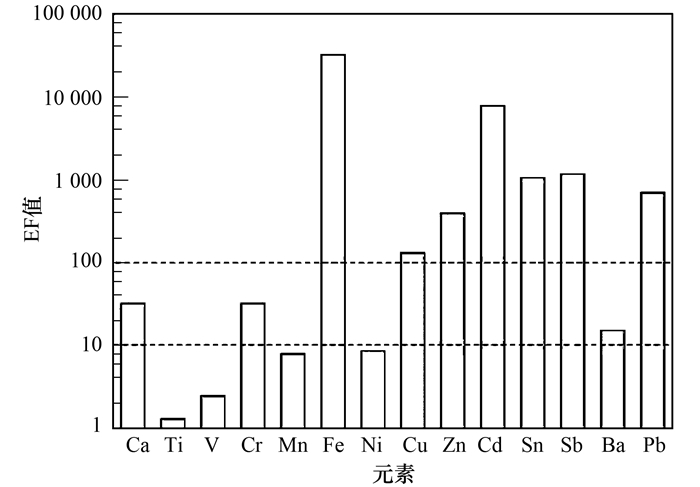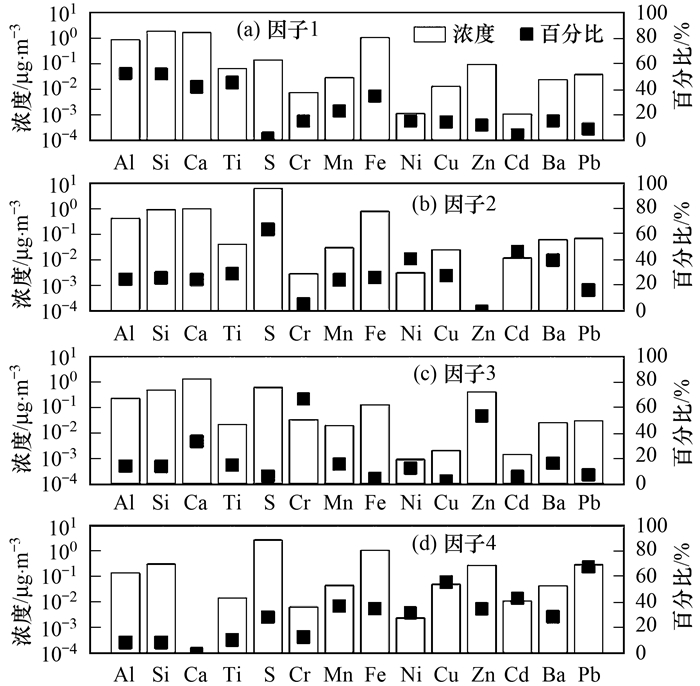2. 中国科学院地球环境研究所气溶胶化学与物理重点实验室, 西安 710061;
3. 西安交通大学全球气候变化研究院, 西安 710049
2. Key Laboratory of Aerosol Chemistry & Physics, Institute of Earth Environment, Chinese Academy of Sciences, Xi'an 710061, China;
3. Institute of Global Environmental Change, Xi'an Jiaotong University, Xi'an 710049, China
大气颗粒物不仅能影响大气辐射平衡, 改变自然界的能量收支平衡, 对全球气候变化产生直接的影响[1~5], 而且对人体健康和环境质量有重要影响[6~10], 因此成为全球关注的焦点.可吸入颗粒物(PM10)是指空气动力学当量直径小于等于10 μm的颗粒物.虽然PM10在大气成分中所占比例很小, 但它由于粒径粗, 易富集和携带大量的有机污染物(如PAHs、诱变剂)、重金属等有毒有害物质, 对人体健康有较大的风险.流行病学的研究已经表明, 大气PM10和成人发病率和死亡率之间存在正相关关系[11, 12], 且这种健康效应可能与颗粒物的化学组成和粒径分布有关[13].
鄂东地区作为我国重要的原材料供应基地, 冶金建材原料的矿产资源十分丰富, 是湖北省重要的重工业区域[14].黄石市位于湖北省东南部, 作为武汉城市圈副中心城市, 金属和非金属矿产资源储量丰富, 矿产品种齐全.黄石的矿冶文化从商周开始一直持续到今天, 是典型的中华民族矿冶文明百科全书, 是中国近代工业的重要发源地.延续2 000多年的矿产资源开采及冶炼给黄石市带来了许多生态环境问题, 特别是重金属污染问题十分严峻.许多研究发现该地区的土壤[15~17]、沉积物[18~21]、街道尘[22]和水体[23~25]中重金属严重超标, 极大地威胁当地的生态环境安全和人群健康.然而, 目前关于黄石市大气颗粒物重金属的研究还鲜有报道[26, 27].因此, 开展矿冶城市PM10中元素组成、变化特征以及来源解析等方面的研究具有重要的现实意义.基于此, 本研究通过在黄石团城山经济开发区设置采样点采集PM10样品, 分析并探讨其元素组成及污染特征, 同时利用主成分分析法(PCA)和正定矩阵因子分析模型(PMF)对PM10中元素来源进行分析, 以期为黄石市大气污染防治和保护人群健康等方面提供基础数据和科学依据.
1 材料与方法 1.1 样品采集采样点位于湖北理工学院环境科学与工程学院楼顶, 距离地面高度约17 m.采样时间为2012年4月3日至2013年2月27日期间, 采用MiniVol(Airmetrics, 美国)便携式颗粒物采样器每隔6 d采样一次, 每次连续24 h(早晨09:00至次日早晨09:00) 采集PM10样品, 流速为5 L·min-1.共采集有效滤膜样品55个, 其中春季10个, 夏季16个, 秋季14个, 冬季15个.所有采样滤膜为直径47 mm的Teflon滤膜(Whatman, 英国).滤膜在采样前后均放置在恒温恒湿箱中(温度为20℃±2℃, 相对湿度为40%±5%)平衡24 h以上, 并采用精度为1 μg电子微量天平(Sartorius, 德国)进行称量, 直至前后两次称量结果在允许误差范围以内, 之后放入冰箱低温保存.
1.2 PM10样品中元素的测定使用能量色散仪型X荧光光谱仪(XRF, Panalytical E5, Netherlands)对Teflon采样膜上气溶胶所含的17种元素进行了测定, 具体分析方法及步骤见文献[28].所有样品的分析均在中国科学院气溶胶化学与物理重点实验室完成.
1.3 PMF源解析正定矩阵因子分解法(positive matrix factorization, PMF)是由Paatero等[29]提出的一种颗粒物源解析方法, 是美国国家环保署(EPA)和我国环保部推荐的大气颗粒物源解析工具.本研究选用PMF5.0版本, 考虑到V、Sn和Sb这3种元素的S/N(信/噪比)低于0.1, 因此分析时模型中只有14种元素.
2 结果与讨论 2.1 元素季节变化特征表 1中统计了不同季节各元素的浓度水平.总体来看, S元素浓度最高.除Ti以外, 地壳元素(Al、Si、Ca、Fe)的浓度明显高于其它各元素丰度.重金属元素中Sn年均浓度最高, 年均值达到(2.27±0.17)μg·m-3, 其次是Zn(0.81±0.53)μg·m-3和Pb(0.46±0.34)μg·m-3, 浓度最低的是Ni和V.从季节变化来看, 5种地壳元素浓度均呈现夏季最低, 春季最高的变化特征, 秋冬季介于春、夏之间.这可能与黄石地区季节性降水分布有关, 由于夏季降水比较集中, 雨水的冲刷作用使得大气颗粒物中地壳元素浓度和地表扬尘显著减少; 春季由于天气干燥, 刮风时不仅会扬起城市街道、建筑工地和工厂的灰尘, 还可能将北方的沙尘输送到黄石地区, 因此地壳元素含量明显较高.而其他各重金属元素浓度的季节变化与地壳元素存在一定的差异, 个别元素的季节变化特征不明显(如V、Ni、Sn和Sb), 其它元素均呈现冬季最高夏季最低的变化趋势, 这可能与黄石地区冬季化石燃料燃烧增多有关.
|
|
表 1 PM10中各元素含量统计/μg·m-3 Table 1 Summary of measured element concentrations of PM10/μg·m-3 |
与我国《环境空气质量标准》(GB 3095-2012) 中Pb和Cd的年均浓度限值(分别为0.5和0.005 μg·m-3)相比, 黄石地区PM10中Pb年均浓度未超标, 但全年超标天数为20 d, 超标率达到36.4%. Cd年均浓度明显超过国家二级标准限值, 全年超标天数为49 d, 超标率高达89.1%;且4个季节平均超标4~6倍, 浓度最高日甚至超标32倍, 应引起相关部门的高度重视.
2.2 富集因子分析富集因子法(EF)用于表征微量元素相对于地壳元素的富集程度, 是判断颗粒物主要来自天然源和人为源的有效方法[30, 31].富集因子计算公式如下:

|
式中, (Xi/Xn)大气为气溶胶中待测元素与参比元素浓度之比; (Xi/Xn)地壳为地壳中待测元素与参比元素浓度之比.一般常用Al、Fe、Ti、Si等作为参考元素, 本研究中选取Al元素作为地壳源的参比元素, 依据湖北省A层土壤元素背景含量(中国土壤元素背景值)计算PM10中各元素的EF值, 结果如图 1所示.

|
图 1 PM10中14种元素的富集因子 Fig. 1 Enrichment factors for the fourteen elements in the PM10 measurement in Huangshi |
一般认为, EF≤1时, 主要受地壳源的影响; 1<EF≤10时, 说明该元素受到人为污染源和自然源的共同影响; EF>10时, 说明该元素主要由人为源贡献[32].从图 1可以看出, Ti、V、Mn和Ni元素的EF值介于1~10之间, 处于轻度富集水平, 说明它们在一定程度上已经受到人为源的影响; Ca、Cr和Ba元素EF值介于10~100之间, 处于中度富集水平, 说明这3种元素受到较为明显的人为源影响.特别是Ca可能与黄石地区石灰岩开采、水泥制造或建筑扬尘的影响有关.而金属元素Cu、Zn和Pb的EF值普遍高于100, 其中Cd、Sn和Sb的EF值超过1 000, Fe的EF值甚至达到32 213, 说明PM10中这些元素的污染已经非常严重, 主要来源于人为污染, 可能受露天采矿、金属冶炼、工业排放、燃煤和机动车尾气排放等的影响.
2.3 来源解析 2.3.1 主成分分析对PM10中14种元素进行主成分分析, 结果见表 2.从中可以看出, 前4个因子提取了总方差的81.41%, 表明这4个主成分可解释元素的绝大多数信息.
|
|
表 2 PM10中各元素的因子载荷矩阵 Table 2 Results matrix for the principal component analysis loadings for elements in the PM10 |
因子1对总方差的贡献率为29.93%(表 2), Al、Si、Ca、Ti和Fe元素载荷较高.这些元素是地壳源或土壤尘的重要标志物[5, 33, 34].黄石城区分布有石灰岩矿区7处, 且大多矿区采用露天开采方式, 再加上较多的水泥厂分布, 这些排放源可能对因子1产生一定的贡献.研究发现黄石大气降尘中Fe元素高度富集, 因此道路交通扬尘也可能是一个重要的贡献源[35].所以因子1与地壳源和土壤飘尘有关.
因子2对总方差的贡献率为20.69%, 载荷较高的元素是S、Cu、Zn、Cd和Pb. S和Pb是燃煤的主要标志物[36]; 而Cu、Zn、Cd和Pb与金属冶炼等来源密切相关[5, 33].前述富集因子分析结果表明Cu、Zn、Cd和Pb在黄石市PM10中高度富集, 主要受人为源的影响.黄石是我国重要的铁矿和有色矿产生产基地, 金属制造和加工、金属冶炼企业较多, 这些工业活动可能对PM10中重金属元素有重要贡献.韩力慧等[36]对北京大气气溶胶中金属元素的研究表明Cu、Zn、Cd和Pb等都受到燃煤的重要影响.因此, 因子2与金属冶炼和燃煤活动有密切关系.
因子3对总方差的贡献率为19.14%, 载荷较高的元素是Cr、Mn、Ni和Zn. Cr和Mn是金属铸造、矿山开采和冶金行业排放的主要元素, Ni和Zn主要来源于冶金尘[32].说明因子3与冶金工业排放密切相关.
因子4中载荷较高的元素是Ba、Al和Cu, 对总方差的贡献率为11.65%. Ba经常用作机动车源的指示元素[33, 37].而Cu除了来自机动车尾气以外, 还可能来源于机动车刹车片和轮胎磨损[37~39].所以, 因子4与机动车排放有关.
2.3.2 PMF分析采用PMF方法对PM10中的14个元素组分进行来源解析, 经过多次运行分析比较, 最终确定了4个因子, 源解析的结果见图 2.

|
图 2 PM10中元素的PMF源解析 Fig. 2 Source profiles for elements in the PM10 resolved by PMF |
因子1中Al、Si、Ca、Ti的载荷最大, 分别贡献了总量的52.40%、51.94%、41.92%和45.28%, Fe也有较大的载荷, 贡献了总量的34.76%.富集因子分析结果显示这4种元素在PM10中都存在一定程度的富集, 说明受到人为源和自然源的双重影响.可以确定因子1代表地壳源, 还可能与地表扬尘有关.
因子2中S有最大载荷, 贡献了总量的63.78%, Cd、Ni和Ba也有较大的载荷, 贡献了总量的40%左右. S是燃煤的重要标志物, Cd被认为是机动车燃油排放的代表性元素, 也来源于燃煤排放和工业烟尘[40]. Ni可以来源于机动车排放[5], 同时也可能受燃煤排放的影响[41].因此, 因子2可确定为燃煤排放源.
因子3中Cr和Zn的载荷最大, 分别贡献了总量的66.85%和53.5%. Cr是冶金化工行业排放烟尘的标志性元素[42]; Zn除了来源于机动车尾气和轮胎磨损外[37, 43], 金属冶炼也是其重要来源之一[36].因此, 因子3代表冶金工业排放源.
因子4中Pb、Cu和Cd的载荷较大, 分别贡献了总量的67.50%、55.63%和43.09%, Mn、Fe、Ni、Zn和Ba约贡献了总量的30%左右. Pb虽然是燃煤排放的特征元素[36], 但同时也来自机动车燃油的排放[28]. Cu主要来源于机动车尾气、轮胎和刹车片磨损排放[33]. Fe、Zn和Mn与道路交通扬尘有关[44].因此, 因子4可确定为机动车排放源.
3 结论(1) 黄石城区PM10中S元素质量浓度最高, 年均值达到9.83 μg·m-3, V和Ni年均浓度最低, 均为0.01 μg·m-3.地壳元素Al、Si、Ca、Ti和Fe的质量浓度均呈现春高夏低的变化特征, 秋冬季介于春、夏之间.与国家二级标准限值相比, 监测期间Pb元素日超标率达到36.4%, 而Cd元素平均超标4~6倍, 日超标率高达89.1%.
(2) 富集因子分析结果表明, Ti、V、Mn和Ni元素的EF值小于10, 存在轻度富集; Ca、Cr和Ba元素EF值介于10~100之间, 处于中度富集水平; Fe、Cu、Zn、Cd、Sn、Sb和Pb的EF值普遍高于100, 说明这些元素的污染已经非常严重, 主要与人为源污染排放有关, 受土壤扬尘源的影响很小.
(3) 主成分分析和PMF源解析结果表明黄石城区PM10中元素主要来自于4类源:第Ⅰ类为地壳源/土壤扬尘(Al、Si、Ca、Ti、Fe), 第Ⅱ类为燃煤源(S、Cd和Ni), 第Ⅲ类为工业源(Cr、Zn、Mn), 第Ⅳ类为机动车源(Cu、Pb和Ba), 且两种方法的解析结果较为一致.
| [1] | Charlson R J, Schwartz S E, Hales J M, et al. Climate forcing by anthropogenic aerosols[J]. Science, 1992, 255(5043): 423-430. DOI:10.1126/science.255.5043.423 |
| [2] | Pöschl U. Atmospheric aerosols:composition, transformation, climate and health effects[J]. Angewandte Chemie International Edition, 2005, 44(46): 7520-7540. DOI:10.1002/(ISSN)1521-3773 |
| [3] | Ramanathan V, Crutzen P J, Kiehl J K, et al. Aerosols, climate, and the hydrological cycle[J]. Science, 2001, 294(5549): 2119-2124. DOI:10.1126/science.1064034 |
| [4] | Booth B B B, Dunstone N J, Halloran P R, et al. Aerosols implicated as a prime driver of twentieth-century North Atlantic climate variability[J]. Nature, 2012, 484(7393): 228-232. DOI:10.1038/nature10946 |
| [5] | Alleman L Y, Lamaison L, Perdrix E, et al. PM10 metal concentrations and source identification using positive matrix factorization and wind sectoring in a French industrial zone[J]. Atmospheric Research, 2010, 96(4): 612-625. DOI:10.1016/j.atmosres.2010.02.008 |
| [6] | Brook R D, Rajagopalan S, Pope C A, et al. Particulate matter air pollution and cardiovascular disease:an update to the scientific statement from the American Heart Association[J]. Circulation, 2010, 121(21): 2331-2378. DOI:10.1161/CIR.0b013e3181dbece1 |
| [7] | Davidson C I, Phalen R F, Solomon P A. Airborne particulate matter and human health:a review[J]. Aerosol Science and Technology, 2005, 39(8): 737-749. DOI:10.1080/02786820500191348 |
| [8] | Pope Ⅲ C A, Burnett R T, Thun M J, et al. Lung cancer, cardiopulmonary mortality, and long-term exposure to fine particulate air pollution[J]. JAMA, 2002, 287(9): 1132-1141. DOI:10.1001/jama.287.9.1132 |
| [9] | Samet J M, Dominici F, Curriero F C, et al. Fine particulate air pollution and mortality in 20 U.S. cities, 1987-1994[J]. The New England Journal of Medicine, 2000, 343(24): 1742-1749. DOI:10.1056/NEJM200012143432401 |
| [10] | Pui D Y H, Chen S C, Zuo Z L. PM2.5 in China:measurements, sources, visibility and health effects, and mitigation[J]. Particuology, 2014, 13: 1-26. DOI:10.1016/j.partic.2013.11.001 |
| [11] | Pope Ⅲ C A, Dockery D W, Spengler J D, et al. Respiratory health and PM10 pollution:a daily time series analysis[J]. American Review of Respiratory Disease, 1991, 144(3 Pt 1): 668-674. |
| [12] | Medina S, Plasencia A, Ballester F, et al. Apheis:public health impact of PM10 in 19 European cities[J]. Journal of Epidemiology & Community Health, 2004, 58(10): 831-836. |
| [13] |
杜鹏瑞, 杜睿, 任伟珊. 城市大气颗粒物毒性效应及机制的研究进展[J]. 中国环境科学, 2016, 36(9): 2815-2827. Du P R, Du R, Ren W S. Research progress on toxicological characteristics and mechanisms of urban atmospheric particulate matters[J]. China Environmental Science, 2016, 36(9): 2815-2827. |
| [14] |
任晓华, 易朝路. 京九铁路对鄂东地区经济发展的影响及产业发展思路[J]. 华中师范大学学报(自然科学版), 1999, 33(2): 301-305. Ren X H, Yi C L. Influence of the railway from Beijing to Jiulong on the economy of eastern Hubei province and suggestions for the development of its major industries[J]. Journal of Central China Normal University (Natural Sciences), 1999, 33(2): 301-305. |
| [15] |
陈华勇, 欧阳建平, 马振东. 大冶有色冶炼厂附近农田镉污染的现状与治理对策[J]. 土壤, 2003, 35(1): 76-79, 82. Chen H Y, OuYang J P, Ma Z D. Status quo of and countermeasures for Cd contamination of farml and in the vicinity of Daye Smeltery[J]. Soils, 2003, 35(1): 76-79, 82. |
| [16] |
孙清斌, 尹春芹, 邓金锋, 等. 大冶矿区周边农田土壤和油菜重金属污染特征研究[J]. 农业环境科学学报, 2012, 31(1): 85-91. Sun Q B, Yin C Q, Deng J F, et al. Investigation on the heavy metal contamination of farmland soil and Brassica Campestris nearby mining areas in Daye City, China[J]. Journal of Agro-Environment Science, 2012, 31(1): 85-91. |
| [17] | Yan S, Ling Q C, Bao Z Y. Metals contamination in soils and vegetables in metal smelter contaminated sites in Huangshi, China[J]. Bulletin of Environmental Contamination and Toxicology, 2007, 79(4): 361-366. DOI:10.1007/s00128-007-9219-2 |
| [18] |
贺跃, 胡艳华, 王秋潇, 等. 大冶大港河水系沉积物中重金属来源分析[J]. 地球化学, 2011, 40(3): 258-265. He Y, Hu Y H, Wang Q X, et al. Analysis on the source of heavy metals in the Dagang River, Daye County, Hubei Province[J]. Geochimica, 2011, 40(3): 258-265. |
| [19] | Zhang J, Li Z H, Chen J, et al. Assessment of heavy metal contamination status in sediments and identification of pollution source in Daye Lake, Central China[J]. Environmental Earth Sciences, 2014, 72(4): 1279-1288. DOI:10.1007/s12665-014-3047-6 |
| [20] |
张家泉, 胡天鹏, 张勇, 等. 磁湖表层沉积物重金属污染特征及生态风险评价[J]. 地球与环境, 2014, 42(5): 639-645. Zhang J Q, Hu T P, Zhang Y, et al. Pollution Characteristics and ecological risk assessment of heavy metals in surface sediments from the Cihu Lake in Huangshi City[J]. Earth and Environment, 2014, 42(5): 639-645. |
| [21] |
张家泉, 田倩, 许大毛, 等. 大冶湖表层水和沉积物中重金属污染特征与风险评价[J]. 环境科学, 2017, 38(6): 2355-2363. Zhang J Q, Tian Q, Xu D M, et al. Pollution characteristics and risk assessment of heavy metals in water and sediment from Daye Lake[J]. Environmental Science, 2017, 38(6): 2355-2363. |
| [22] |
韩晓涛, 郭宇, 鲍征宇, 等. 大冶市街尘重金属污染评价及化学形态特征[J]. 地球化学, 2012, 41(6): 585-592. Han X T, Guo Y, Bao Z Y, et al. The level and speciation of metals in street dusts of Daye, Hubei Province[J]. Geochimica, 2012, 41(6): 585-592. |
| [23] |
谢先军, 韩吟文. 黄石巷子口地区水环境重金属污染评价与防治对策[J]. 安全与环境工程, 2003, 10(4): 34-36, 60. Xie X J, Han Y W. Evaluation and measures on heavy metal pollution in Xingzikou area of Huangshi[J]. Safety and Environmental Engineering, 2003, 10(4): 34-36, 60. |
| [24] |
毛欣, 陈旭, 李长安, 等. 大冶市城市湖泊表层水体中重金属的分布特征及其来源[J]. 安全与环境工程, 2013, 20(5): 33-37, 84. Mao X, Chen X, Li C A, et al. Distribution of heavy metal elements in surface water from three lakes in Daye City[J]. Safety and Environmental Engineering, 2013, 20(5): 33-37, 84. |
| [25] |
刘煦爽, 熊小琴, 高欣, 等. 大冶铜绿山附近水体重金属污染及鱼体富集状况调查[J]. 湖北大学学报(自然科学版), 2016, 38(3): 246-251. Liu X S, Xiong X Q, Gao X, et al. A survey on heavy metal pollution of waters and fish in nearby areas of the Tonglüshan Copper Mine, Daye City[J]. Journal of Hubei University (Natural Science), 2016, 38(3): 246-251. |
| [26] |
张禾. 黄石市冬/春季大气PM10中重金属形态特征研究[J]. 环境污染与防治, 2015, 37(4): 71-77, 83. Zhang H. Research on chemical species of atmospheric particulate heavy metals in Huangshi City in winter and spring[J]. Environmental Pollution & Control, 2015, 37(4): 71-77, 83. |
| [27] | 李秀, 张勇, 张家泉, 等. 黄石城区夏季大气PM10/PM2.5中元素特征分析[J]. 环境化学, 2014, 33(2): 357-358. DOI:10.7524/j.issn.0254-6108.2014.02.024 |
| [28] | Xu H M, Cao J J, Ho K F, et al. Lead concentrations in fine particulate matter after the phasing out of leaded gasoline in Xi'an, China[J]. Atmospheric Environment, 2012, 46: 217-224. DOI:10.1016/j.atmosenv.2011.09.078 |
| [29] | Paatero P, Tapper U. Analysis of different modes of factor analysis as least squares fit problems[J]. Chemometrics and Intelligent Laboratory Systems, 1993, 18(2): 183-194. DOI:10.1016/0169-7439(93)80055-M |
| [30] | Bilos C, Colombo J C, Skorupka C N, et al. Sources, distribution and variability of airborne trace metals in La Plata City area, Argentina[J]. Environmental Pollution, 2001, 111(1): 149-158. DOI:10.1016/S0269-7491(99)00328-0 |
| [31] | Waked A, Favez O, Alleman L Y, et al. Source apportionment of PM10 in a north-western Europe regional urban background site (Lens, France) using positive matrix factorization and including primary biogenic emissions[J]. Atmospheric Chemistry and Physics, 2014, 14(7): 3325-3346. DOI:10.5194/acp-14-3325-2014 |
| [32] |
杨怀金, 杨德容, 叶芝祥, 等. 成都西南郊区春季PM2.5中元素特征及重金属潜在生态风险评价[J]. 环境科学, 2016, 37(12): 4490-4503. Yang H J, Yang D R, Ye Z X, et al. Characteristics of elements and potential ecological risk assessment of heavy metals in PM2.5 at the southwest suburb of Chengdu in spring[J]. Environmental Science, 2016, 37(12): 4490-4503. |
| [33] | Lim J M, Lee J H, Moon J H, et al. Source apportionment of PM10 at a small industrial area using Positive Matrix Factorization[J]. Atmospheric Research, 2010, 95(1): 88-100. DOI:10.1016/j.atmosres.2009.08.009 |
| [34] | Santoso M, Hopke P K, Hidayat A, et al. Sources identification of the atmospheric aerosol at urban and suburban sites in Indonesia by positive matrix factorization[J]. Science of the Total Environment, 2008, 397(1-3): 229-237. DOI:10.1016/j.scitotenv.2008.01.057 |
| [35] | Zhang J Q, Zhan C L, Liu H X, et al. Characterization of polycyclic aromatic hydrocarbons (PAHs), iron and black carbon within street dust from a steel industrial city, central China[J]. Aerosol and Air Quality Research, 2016, 16(10): 2452-2461. DOI:10.4209/aaqr.2016.02.0085 |
| [36] |
韩力慧, 张鹏, 张海亮, 等. 北京市大气细颗粒物污染与来源解析研究[J]. 中国环境科学, 2016, 36(11): 3203-3210. Han L H, Zhang P, Zhang H L, et al. Pollution and source apportionment of atmospheric fine particles in Beijing[J]. China Environmental Science, 2016, 36(11): 3203-3210. DOI:10.3969/j.issn.1000-6923.2016.11.001 |
| [37] | Johansson C, Norman M, Burman L. Road traffic emission factors for heavy metals[J]. Atmospheric Environment, 2009, 43(31): 4681-4688. DOI:10.1016/j.atmosenv.2008.10.024 |
| [38] | Ho K F, Lee S C, Chow J C, et al. Characterization of PM10 and PM2.5 source profiles for fugitive dust in Hong Kong[J]. Atmospheric Environment, 2003, 37(8): 1023-1032. DOI:10.1016/S1352-2310(02)01028-2 |
| [39] |
石爱军, 马俊文, 耿春梅, 等. 北京市机动车尾气排放PM10组分特征研究[J]. 中国环境监测, 2014, 30(4): 44-49. Shi A J, Ma J W, Geng C M, et al. Characteristics of chemical composition of particulate matter (PM10) from Beijing vehicle[J]. Environmetal Monitoring in China, 2014, 30(4): 44-49. |
| [40] | Ambade B. Seasonal variation and sources of heavy metals in hilltop of Dongargarh, Central India[J]. Urban Climate, 2014, 9: 155-165. DOI:10.1016/j.uclim.2014.08.001 |
| [41] |
侯聪, 邵龙义, 王静, 等. 燃煤排放可吸入颗粒物中微量元素的分布特征[J]. 煤炭学报, 2016, 41(3): 760-768. Hou C, Shao L Y, Wang J, et al. Distribution of trace elements in inhalable particulate matter emitted from coal burning[J]. Journal of China Coal Society, 2016, 41(3): 760-768. |
| [42] |
刘菁, 张建强, 吴香尧, 等. 成都市十里店地区大气气溶胶元素组成及来源解析[J]. 成都理工大学学报(自然科学版), 2006, 33(1): 99-102. Liu J, Zhang J Q, Wu X Y, et al. Element components and sources analysis of atmospheric aerosols in the Shilidian area of Chengdu, China[J]. Journal of Chengdu University of Tech-nology (Science & Technology Edition), 2006, 33(1): 99-102. |
| [43] | Amato F, Viana M, Richard A, et al. Size and time-resolved roadside enrichment of atmospheric particulate pollutants[J]. Atmospheric Chemistry and Physics, 2011, 11(6): 2917-2931. DOI:10.5194/acp-11-2917-2011 |
| [44] | Jena S, Singh G. Human health risk assessment of airborne trace elements in Dhanbad, India[J]. Atmospheric Pollution Research, 2017, 8(3): 490-502. DOI:10.1016/j.apr.2016.12.003 |
 2017, Vol. 38
2017, Vol. 38


